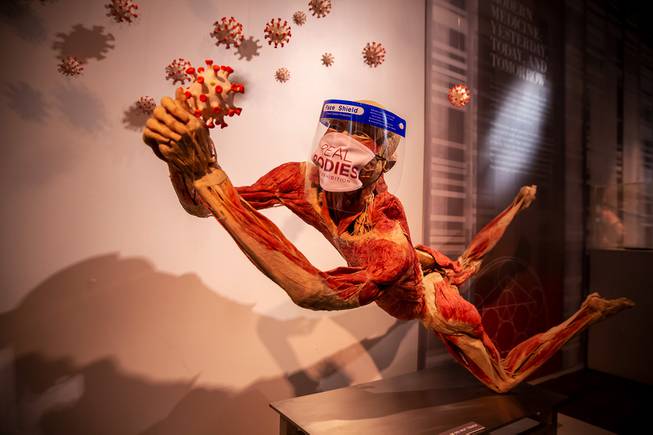
A look at Real Bodies at Ballys’ new COVID-19 expansion, Thursday Jan. 21, 2020.
Saturday, Feb. 6, 2021 | 2 a.m.
Operating amid the biggest health crisis of a lifetime, the Real Bodies exhibit at Bally’s has scrambled to tell the story of the coronavirus pandemic.
"They really thought about this early on in the pandemic when there was a lot of misinformation, a lot of fear among the general public," said Anna Yaffee, an epidemiologist from Atlanta who consulted on retooling the museum-style attraction.
The exhibit explores the “elegance, complexity and mystery” of the human body through more than 20 preserved bodies and over 200 anatomical specimens.
The information on the coronavirus was added to illustrate the “complexity of viral infection, the science behind common symptoms and the challenges that health care workers face in treating and preventing the virus,” according to the Real Bodies website.
"Anything we can do to make sure that it's scientifically sound and we stay on our messaging is really important," Yaffee said.
Cristian Rojas, 24, of California, who recently toured the attraction, is a coronavirus survivor and said the exhibit gave him a better idea of how the disease might have impacted his body.
“I'm hoping it helps us realize there are ways to survive this deadly virus, a way for us to learn how to prevent it,” he said.
Cindy Wilson, a visitor from Texas, said coronavirus has become such a part of everyday life that it would be strange if any exhibit about human bodies left out information about COVID-19.
"I've seen so much virus stuff already, it seems normal," she said.
The exhibit includes a short film explaining in plain language how the virus impacts the body and spreads.
As visitors explore the exhibit’s 11 galleries, they learn about COVID-19 in the context of each major system of the human anatomy — from respiration to digestion to circulation. The Repair Gallery, which explores how the body recovers from illness and injury, features dozens of 3D models of the coronavirus.
Real Bodies also addresses treatment of the virus and the cascading effects the pandemic has had on health and health care beyond what is directly attributable to the virus.
Tom Zaller, president and CEO of Imagine Exhibitions, the company that operates Real Bodies, said the coronavirus installation “allows a mysterious disease to become tangible.”
“By making the virus visual, we are giving our visitors a chance to see the coronavirus in a way they never have before,” he said. “Our installation allows guests to reflect upon their individual experiences while fighting the pandemic collectively.”
It was important the coronavirus elements fit within the framework of the overall exhibit, which involves more than anatomy, Zaller said.
"Certainly, there's an anatomy lesson in there, but we're trying to be more thoughtful and maybe even a little philosophical,” he said.
The exhibit doesn’t include any specimens impacted by COVID-19. But they could be added when there is “a better understanding of the coronavirus, so we can use a specimen to tell a story of endurance,” Zaller said.
Real Bodies is open daily from 11 a.m. to 8 p.m. Tickets, which are $29.50 for adults and $19.50 for children, can be purchased at www.realbodiesatballys.com.

